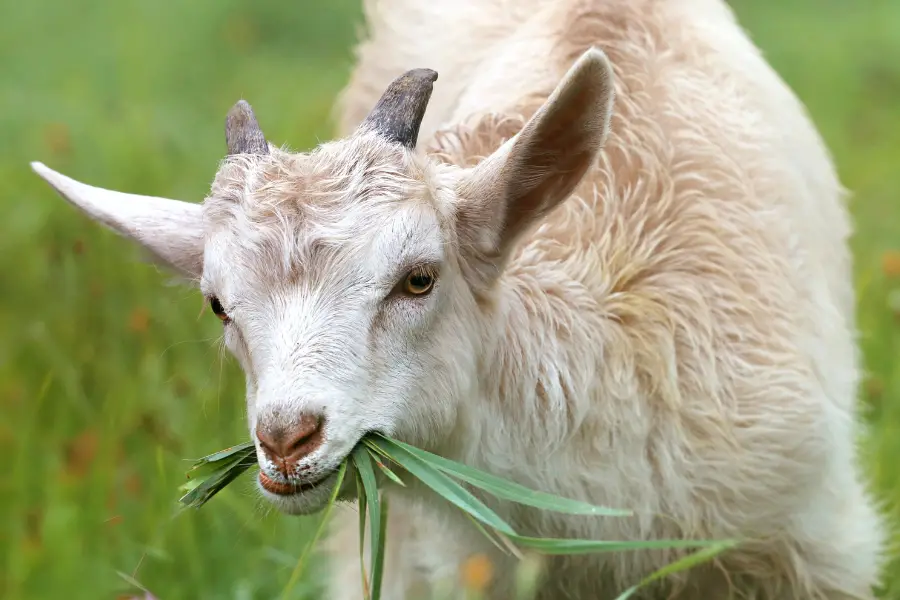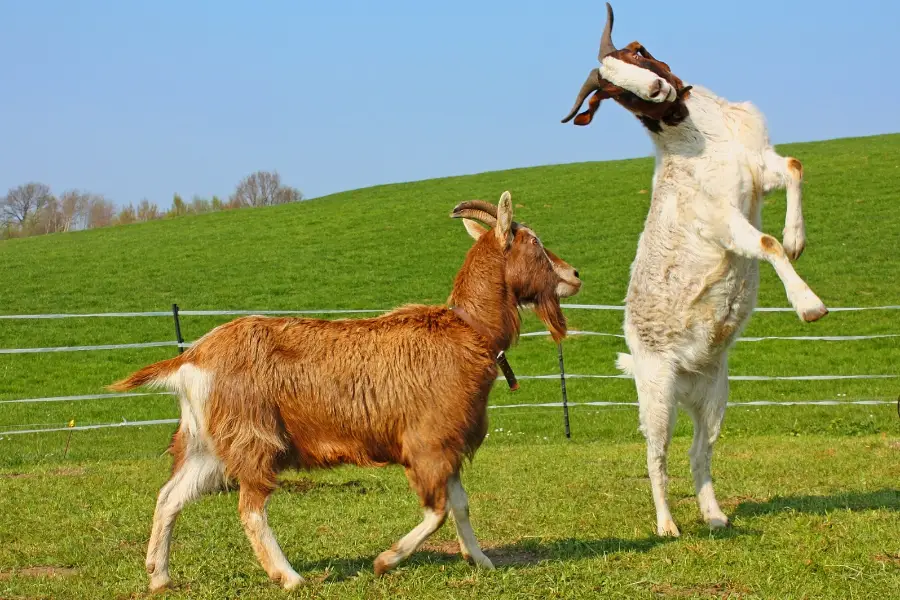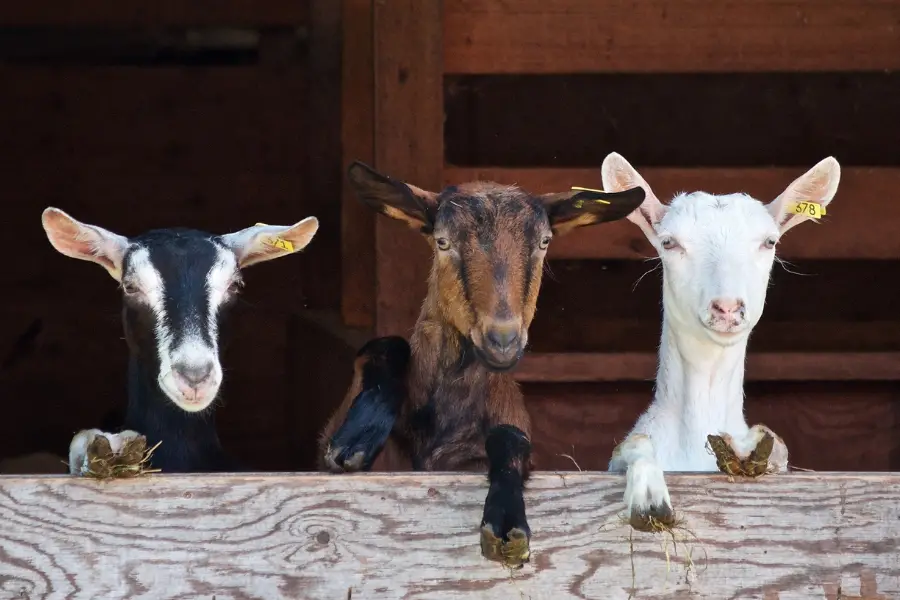
Oberhasli goats have a handsome coloring, docile disposition, and excellent milk production. Goat milk from Oberhasli goats is sweet and smooth, and tastes similar to cow’s milk. However, goat milk is easier to digest than cow’s milk. The breed is relatively new, only formally recognized in 1978, and is still fairly uncommon. Oberhasli goats are fast becoming a favorite among dairy goat farmers and breeders, pet owners, and even as working goats.
Table of contents
- Oberhasli Goat Origin
- Goat Uses
- Oberhasli Goat Characteristics
- Breeding Oberhasli Goats
- Owning a sire
- Oberhasli Goat Farming
- Oberhasli goats care: Top tips
- Oberhasli goat associations: What are the major Oberhasli goat associations in the USA?
- Oberhasli goat milk production: How much milk do they produce?
- Oberhasli goat FAQs
- Conclusion
Oberhasli Goat Origin
Oberhasli goats, also known as Swiss Alpine goats, are a breed of dairy goats that originated in the mountainous region of Switzerland. These beautiful and hardy animals have a rich history and a unique set of characteristics that make them highly valued among goat enthusiasts and farmers worldwide. The story of the origins of Oberhasli goats range from the Swiss Alps to various parts of the world.
Historical Background
The history of Oberhasli goats can be traced back several centuries. They are believed to have originated in the Swiss canton of Bern, particularly in the Oberhasli region, from which they derive their name. The region’s rugged and mountainous terrain provided an ideal environment for the development of a robust and adaptable goat breed.
Breed Development
The exact origins of the Oberhasli breed are somewhat unclear, but it is widely believed that they descended from the Chamois Colored Goat, a breed native to the region. Over time, these goats were selectively bred for their desirable traits, such as milk production, hardiness, and docile temperament. The breeding programs aimed to develop a consistent and standardized breed with distinct characteristics.
Recognition as a Breed
In the early 20th century, efforts were made to promote and preserve the Oberhasli goats as a distinct breed. The Swiss Alpine Breeders Association, founded in 1906, played a crucial role in establishing breed standards and promoting the breed’s recognition. However, it wasn’t until the 1970s that Oberhasli goats gained recognition and popularity outside of Switzerland.
Introduction to the United States
Oberhasli goats made their way to the United States in the mid-20th century. In 1936, a pair of Oberhasli goats was imported by Dr. H.O. Pence, a geneticist from Iowa. These goats were exhibited at the 1937 Iowa State Fair, generating significant interest among the attendees. Following this initial introduction, the breed slowly gained popularity among American goat breeders and enthusiasts.
American Dairy Goat Association Recognition
The American Dairy Goat Association (ADGA) officially recognized Oberhasli goats as a distinct breed in 1977. This recognition marked an important milestone in the breed’s history, as it solidified their status as a valuable dairy goat breed in the United States. Since then, Oberhasli goats have steadily gained recognition and a dedicated following among goat breeders and dairy farmers.
Global Distribution
While Oberhasli goats originated in Switzerland, they have now spread to various parts of the world. Their adaptability and hardiness have made them well-suited for diverse climates. Today, Oberhasli goats can be found in countries such as the United States, Canada, Australia, New Zealand, and several European nations. They continue to thrive and contribute to local dairy industries wherever they are present.
The Oberhasli goats’ journey from the Swiss Alps to becoming a recognized breed worldwide is a testament to their outstanding qualities and the dedication of breeders and enthusiasts. Their rich history, combined with their excellent milk production and adaptability, has made them a cherished breed among dairy goat enthusiasts.
Goat Uses
Oberhasli goats are quite strong for their size, making them excellent pack animals, who are not afraid of water. And their distinctive coats make them appealing as pets and for show animals. They are friendly and calm, and do not easily startle, which makes them easy to live with in a variety of situations. Their thick coats and Swiss origins make them hardy in cold climates. It’s easy to see why the Oberhasli has become such a desirable goat.
Oberhasli Goat Characteristics
Oberhasli goats are medium-sized animals with a distinctive chamois-colored coat. They have a graceful appearance, with alert eyes and upright ears. Both bucks and does have short to medium-length hair. The does are excellent milk producers, with an average lactation period of about 300 days and an average milk yield of 2,000 to 3,000 pounds per year. They are known for their rich and flavorful milk, making them a popular choice among dairy enthusiasts.
Breeding Oberhasli Goats
While a doe can come into heat as early as 5 months old, it is better to wait until she is at least 8 months old or 80 pounds to prevent kidding problems. When she is coming into heat, she will generally show signs with signature behaviors, such as:
When breeding Oberhasli goats, there are a few factors to consider:
Owning a sire
Keeping an Oberhasli buck of your own can be a challenge, as he requires a separate (and very sturdy) enclosure to keep him from breeding when unwanted.
Keeping your own buck ensures that you can breed your does right when they are ready, and allowing him access to the does may bring them into heat. But buying and raising a purebred Oberhasli buck can be an expensive year-round investment, if all that’s needed is to freshen your does.

Oberhasli Goat Farming
The Oberhasli goat is a dairy breed, meaning they’re most famous for their milk. They’re native to Switzerland and are formerly known as the Swiss Alpine. Oberhasli goats made their way to the US in the early 1900s, yet there isn’t a whole lot of them running around.
This breed is rather average in size, and the color of their fur is referred to as Chamoisee. The does are depended upon to produce high-quality milk. Some farmers even use the Oberhasli as packing animals due to their size and ability to overcome obstacles.
Pros of Raising Oberhasli Goats
1. Milk Production
One of the primary reasons farmers choose Oberhasli goats is for their excellent milk production. These goats are known for their milk, which is high in butterfat and protein content. With proper management and nutrition, a single Oberhasli doe can produce an average of 2,000 to 3,000 pounds of milk per year. This makes them a valuable asset for dairy operations or individuals seeking a regular supply of fresh milk for personal use.
2. Adaptability
Oberhasli goats are known for their adaptability to various climates and terrains. They have a thick, short coat that provides good insulation during colder months, making them suitable for both cold and hot climates. Their sturdy build and strong legs enable them to navigate rough terrains, including hilly or mountainous regions. This adaptability makes Oberhasli goats a versatile choice for farmers in diverse geographical locations.
3. Docile Temperament
Oberhasli goats are generally calm, gentle, and easy to handle. They are known for their friendly nature and can develop strong bonds with their caretakers. This makes them ideal for first-time goat owners or families with children, as they are less likely to exhibit aggressive or unpredictable behavior. Additionally, their docile temperament facilitates easier management during milking and other routine husbandry tasks.
4. Versatility
Apart from their excellent milk production, Oberhasli goats can also be utilized for meat production, although they are primarily considered a dairy breed. If managed and fed properly, Oberhasli goats can yield tender and flavorful meat. Their adaptability, medium size, and well-muscled body make them a viable option for those interested in both milk and meat production.
Cons of Raising Oberhasli Goats
1. Space and Fencing Requirements
Oberhasli goats, like any other goat breed, require ample space to roam and graze. They are active animals that thrive when given access to pasture or forage. Therefore, if you have limited space or lack suitable grazing areas, raising Oberhasli goats may pose a challenge. Additionally, proper fencing is essential to keep them contained and protect them from predators, as they are agile climbers and jumpers.
2. Time and Commitment
Raising Oberhasli goats, or any livestock for that matter, demands a significant investment of time and effort. Goats require daily feeding, milking (if kept for dairy purposes), and regular health checks. They also need shelter, clean water, and protection from extreme weather conditions. If you have a busy schedule or limited availability, it may be challenging to meet the goats’ needs adequately.
3. Initial Costs
Acquiring Oberhasli goats can be relatively expensive, especially if you aim to start with quality breeding stock. Additionally, there are associated costs for setting up suitable housing, fencing, and providing proper nutrition. It is crucial to consider the initial investment required to establish a goat operation and ensure you have the necessary funds and resources available.
4. Breeding and Reproduction
Managing breeding and reproduction can be a complex task when raising Oberhasli goats. Breeding requires careful selection of breeding pairs, monitoring heat cycles, and providing appropriate breeding conditions. Furthermore, goat pregnancies last about five months, and the process of kidding (goat birth) can be challenging, requiring assistance in some cases. Adequate knowledge and experience are necessary to navigate the complexities of breeding and ensure successful reproduction.
Oberhasli goats care: Top tips
- Oberhasli goats thrive if they’re getting enough hay, greens, and other nutritious food. The The University of Missouri has compiled a helpful guide detailed with instructions on how to feed your dairy goat.
- This breed is the perfect choice if you’re looking into breeding. Their excellent mothers and breed through late August to early January. According to the American Dairy Goat Association (ADGA), they can also be tricked into thinking the short-day season has begun.
- The Oberhasli should be kept in a ventilated space that’s dry and clean.
- If you rotate your pasture, you’ll minimize the risk of spreading pests and infections.

Oberhasli goat associations: What are the major Oberhasli goat associations in the USA?
- The ADGA
- The Virginia State Dairy Goat Association
- Oberhasli Breeders of America
- Oberhasli Goat Club
Oberhasli goat milk production: How much milk do they produce?

Wide Open Pets states Oberhasli goats produce between ½ and 1-½ gallons of milk a day with a butterfat content ranging from 3.5% to 4%. Per the lactation period, Oberhasli Does can produce 2000 Liters of milk. This is more than enough to make goat milk yogurt and other excellent goat milk products.
- Oberhasli goat FAQs
Oberhasli goat FAQs
Oberhasli goats are distinguishable by their black muzzle, belly, legs, and dorsal stripe, a pattern known as Chamoisee. The rest of their beautiful coat may be light to dark red and brown, and bucks can be all black.
Oberhasli goats can produce 1/2 to 1 1/2 gallons of 3.5% and 4% butterfat milk per day.
As they are active and agile animals, you’ll need an outdoor area of at least 25 square feet for each goat and an additional 15 square feet for bedding per goat. Goats are herding animals so you’ll need to calculate for multiple animals.
Conclusion
Oberhasli goats give good quantities of delicious milk, and are very desirable dairy goats. But their handsome coloring and distinctive looks also make them appealing pets and show animals. And the fact that they can be trained as pack goats adds a special dimension to the many uses of this special breed of goat.




